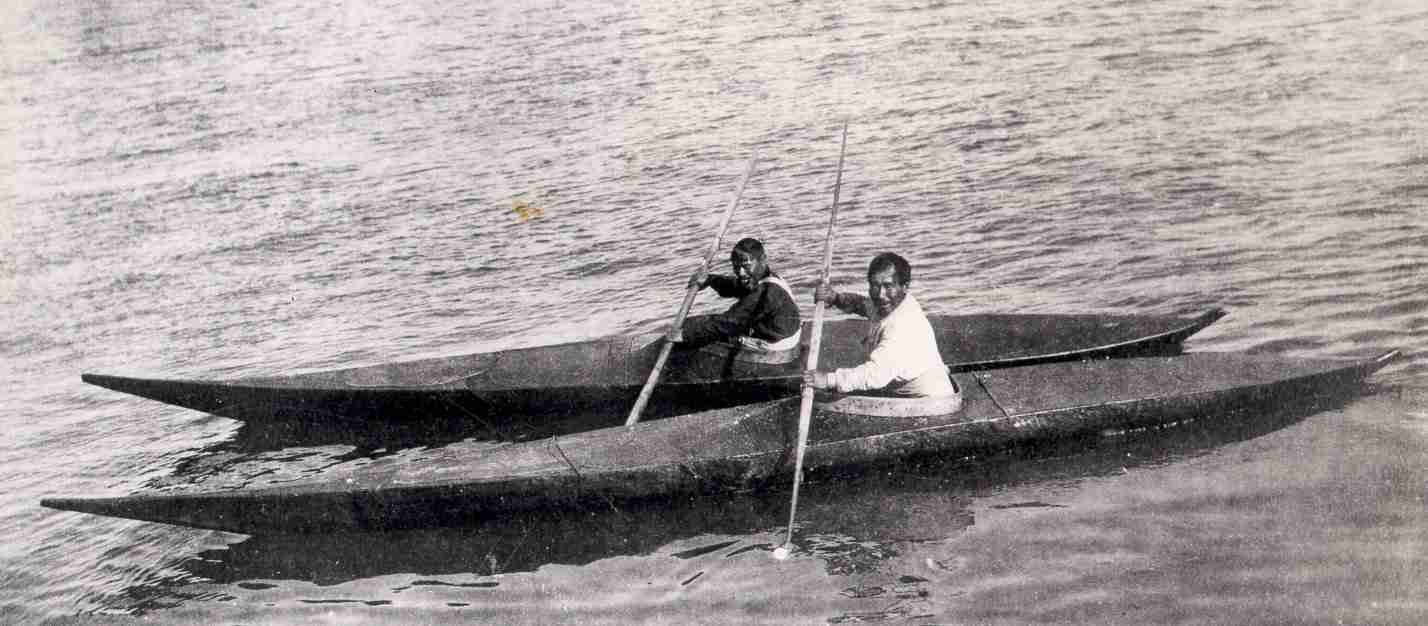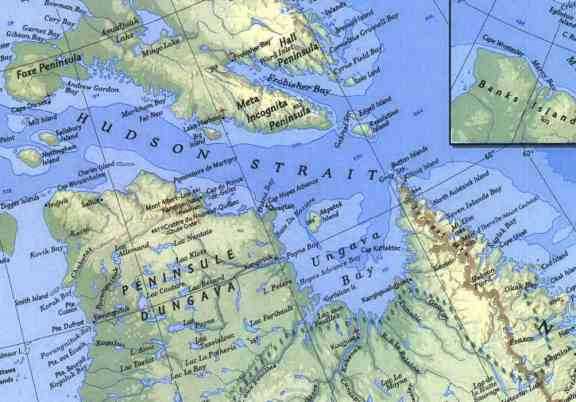Complete manuscript, East
Arctic Kayak: Building a Reconstruction, by David W. Zimmerly in PDF format
(5.1mb).
This is NOT the East Arctic
Kayak in Sea Kayaker 18
To purchase the complete 55-page manuscript, with over
100 photographs, by PDF format, send $10 US by
PayPal
(click the Buy Now below) or check, and we will
send you the
URL (Uniform Resource Locator) for the download of the PDF file.
East
Arctic Kayak:
Building a Reproduction
%20in%20color.jpg)
David
W. Zimmerly
Preface
The following detailed, illustrated instructions
will allow the amateur boat builder to construct an historic replica of
an East Arctic kayak.
Traditionally, Arctic kayaks were built of
driftwood or other salvaged wood and covered with animal hide, usually
sealskin. This replica uses a choice of lumber yard wood, ripped
and worked with modern tools and covered with canvas. Tradition is
honored in the form and construction and the time-honored use of
lashings to tie the frame together. There is not a single nail or
screw used.
The result is a sturdy, yet sleek, comfortable
touring kayak which is a joy to paddle.

Figure 1. Great Whale
River pre 1921, photo by R. C. Harrison, courtesy Public Archives
Table of Contents
| |
Preface |
| |
Table
of Contents |
| |
Introduction |
| |
Kayak Parts |
| |
Bill of Materials |
| |
Tools |
| |
Gunwales |
| |
Scarf Joint |
| |
Stations |
| |
Rib Mortises |
| |
Deck Beam Mortises |
| |
Temporary Masik
and Itivik (forward and rear cockpit deck beams) |
| |
Planing of Bow and
Stern Gunwales |
| |
Final Gunwale Shaping |
| |
Completed Gunwales,
Bow and Stern |
| |
Deck Beams |
| |
Ayaaq
(deck beams) |
| |
Masik
(forward cockpit deck beam) |
| |
Itivik
(aft cockpit deck beam) |
| |
Masirusigiik
(two deck beams forward of the masik) |
| |
Lashing for Gunwale
and Deck Beam |
| |
Lashing of the
Masik and Itivik |
| |
Forward Deck Stringer |
| |
Aft Deck Stringer |
| |
Completed Gunwales, Deck Beams and Deck
Stringers |
| |
Ribs |
| |
Keelson |
| |
Keelson Lashing |
| |
Bilge Stringers |
| |
Side Stringers |
| |
Cockpit Coaming |
| |
Foot Brace |
| |
The Completed Frame |
| |
Covering |
| |
Lacing on the Cockpit Coaming |
| |
Painting |
| |
Floor Boards |
| |
The Completed Covering |
| |
The Completed East Arctic Kayak |
| |
Deck Fittings |
| |
Paddle |
| |
Table of Offsets |
| |
The Completed
Mackenzie Eskimo Paddle |
| |
Addendum |
| |
Knots |
| |
Expenses
For 2 East Arctic Kayaks (Canadian) |

Map 2.
Baffin Island, Hudson Strait, east coast Hudson Bay and Labrador.
Introduction
The East Arctic kayak is flat-bottomed with flared
sides, generous beam and length and a flat deck. Traditionally, it
was heavily built, with plank gunwales, and crude examples look boxy.
Its primary use was for sea mammal hunting, particularly seals. It
was also used for fishing and for general transport in moving from camp
to camp.
Although this kayak had no spray skirt, and had no
capability for rolling, it was used in rough waters and for some
distances. For example the distance between the east coast of
Hudson Bay and the Belcher Islands is over 60 miles. Two or more
kayaks could catamaran together to avoid capsize in rough weather or for
sleeping at sea. This type of kayak was used extensively along the
east coast of Hudson Bay, from Ivuyivik south to Povungnituk and over to
the Belcher Islands, both sides of Hudson Strait, the east coast of
Baffin Island, and the coast of Labrador. The long, flat decks
were ideal for carrying sea mammal carcasses. Parts could be
stuffed inside.
This kayak, in a lighter, recreational version, is
a pleasure to use – extremely stable, roomy, fast, and easy to paddle.
It tracks beautifully, and can carry a high volume of goods, either
stuffed inside, or on deck. If you have seen the classic
documentary film, Nanook of the North, filmed by Robert Flaherty in
1919/20, you will remember the amusing scene where Nanook paddles
ashore, and out of the kayak pulls his wife children and several dogs.
Nanook is paddling this type of East Arctic kayak, but the extraordinary
cargo is, of course, faked, one scene being shot at a time and then
compiled.
I did paddle my first East Arctic reproduction with
several pre-teen children lying on the deck, fore and aft, with no
problem and not too many complaints from the passengers. That kayak
lasted through 14 years, two canvas covers, and many miles of paddling.
When my wife and I sailed our cruising boat, ERASMUS, to Cape Dorset on
Baffin Island, on the first leg of a world voyage, I couldn’t part with
it. Strapped to a side deck, the kayak became a second
tender, and proved invaluable. Suitably, it’s skeleton remains in
Cape Dorset.
That reproduction was made while I was Arctic
Ethnologist at the National Museum of Man in Ottawa, now the Canadian
Museum of Civilization (CMC). My first attempt, a Caribou Eskimo
type, proved disastrous. To try to alter dimensions on that tippy
style (initial stability unstable) was not wise. I looked
eastward. The Museum storage provided some two dozen examples of
the East Arctic kayak.
In addition, my predecessor, Eugene Arima, had done
extensive studies of this type as part of his fieldwork in Arctic
Quebec, and had built several reproductions. He wrote two
unpublished manuscripts ,“How to Build Kayaks of the Canadian Arctic”,
(1975, No. 1005.23, pp. 100, and “How to Build an Eskimo Kayak”, (1973,
No. 1005.20, pp. 79), available in the archives of the Canadian
Ethnology Service, Canadian Museum of Civilization, Ottawa ). In
building my reproduction, I used a combination of Arima’s measurements
and my own modifications, with construction details coming from Arima’s
1973 manuscript and my own studies of examples in the collection of the
CMC. This reproduction is a hybrid, of the various East Arctic
examples.
The result was to remain my favorite of a fleet of
varied Arctic kayak types built subsequently. I constructed that
first East Arctic kayak in 1973. In the fall of 1999, I began
another, the one documented in the accompanying photos. An
enthusiastic neighbour, Bob Taylor, built one following the text and
photos, allowing me to clarify many points. My helpful wife,
Helga, has done extensive editing.
-------
This is just a part of the
complete 55 page manuscript
-------
The Completed East Arctic Kayak

Figure 105. Finished kayak in water - David
Zimmerly.
Expenses for 2
East Arctic Kayaks
March 1, 2000
Sub-total
926.51
1. Decorating by Design – house paint Exterior
Alkyd/Resin –
1 gallon + 2
liters white & blue
85.07
2. The Aero Mart - 2 gal. clear butyrate dope + 1 gal.
Reducer
237.64
3. Home Hardware - brushes, etc.
40.26
4. Decorating by Design – house paint Exterior Alkyd/Resin – 1 liter.
19.54
5. Canadian Tire - fibre glass kit
13.79
6. Home Hardware - spar varnish – 1 liter.
11.50
7. Decorating by Design – house paint Exterior Alkyd/Resin - 2 gal.
92.00
8. Nixon Building Supplies – 18’- 2 x 6 pine & 12’-
5/4 x 6 cedar –
for paddles
50.82
